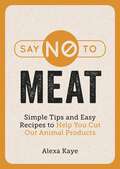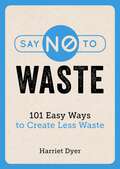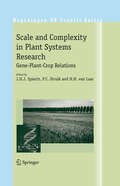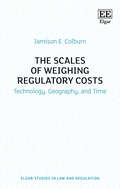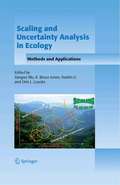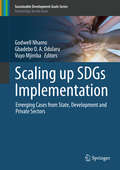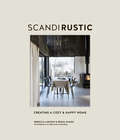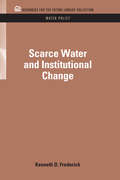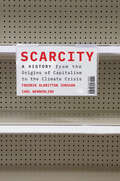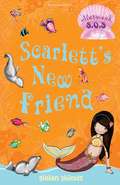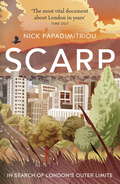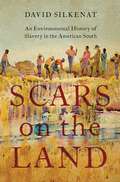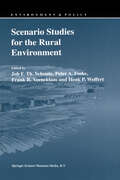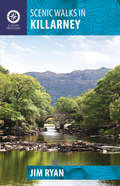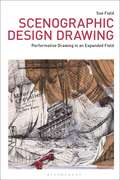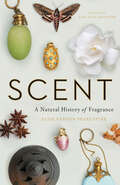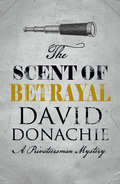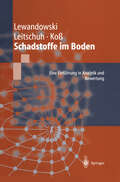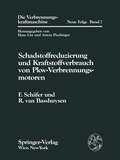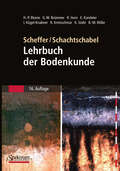- Table View
- List View
Say No to Meat: Simple Tips and Easy Recipes to Help You Cut Out Animal Products
by Alexa KayeCutting out animal products has never been easier!From eco to ethical, there are plenty of sound reasons to eat less meat. It’s possible to make positive changes to your diet without radically altering your lifestyle – and you can still eat tasty, nutritious food without feeling like you’re missing out. This practical book is full of nutritional tips, lifestyle hacks and delicious meat-free recipes, so that you’ll find it easy to take the first step and make a difference.
Say No to Plastic: 101 Easy Ways to Use Less Plastic
by Harriet DyerWe’ve reached an environmental crisis point with plastic, and it’s time to take action. But is it possible to make positive changes without radically changing your lifestyle? Absolutely! This practical book suggests eco-friendly alternatives to plastic, including budget options, high-street substitutes and DIY ideas to help you drastically reduce your plastic consumption. With 101 simple ways to use less plastic, you’ll find it easy to take the first step and make a difference.
Say No to Waste: 101 Easy Ways to Create Less Waste
by Harriet DyerThe world is overflowing with waste. It’s time to take action. You can make positive changes without radically altering your lifestyle. This practical book suggests ways to reduce waste, including how to cut unnecessary packaging, patch up or recycle old household items and drastically limit food waste. With 101 simple ways to create less waste, you’ll find it easy to take the first step and make a difference.
Scale and Complexity in Plant Systems Research: Gene-Plant-Crop Relations (Wageningen UR Frontis Series #21)
The growing demand for food and increasing scarcity of fertile land and other resources (water, energy, etc. ) present multiple challenges to plant and crop scientists to meet the demands of future generations while protecting the environment and conserve biological diversity. Novel directions in linking basic plant sciences to crop and systems research are needed to meet the growing demand for food in a sustainable way. Crop performance can be changed by modifying genetic traits of the plant through plant breeding or changing the crop environment through agronomic management practices. To achieve that, systems analysis and modelling play an important role by integrating and evaluating new findings at the gene and plant level at higher scales of aggregation. Robust crop-physiological modelling can become an essential tool to use insights from functional genomics in explaining crop behaviour. Current crop models can predict crop performance over a range of environmental conditions. Recently QTL information has been incorporated into crop models, and this has proved the potential of narrowing genotype– phenotype gaps and of applying QTL-based models for the analysis of genotype-- environment interactions. To make further progress, model structure must be upgraded to allow for more physiological feedback features. Model input parameters should be designed to be potentially grounded in gene-level understanding. Integration of crop modelling into genetic and genomic researches can enhance the future position of crop physiology in ‘plant breeding by design’ (Yin, X.
The Scales of Weighing Regulatory Costs: Technology, Geography, and Time (Elgar Studies in Law and Regulation)
by Jamison E. ColburnThis book examines the calculation and evaluation of regulatory costs by regulators in accordance with a legislative mandate. A serious limitation in that enterprise, the possibility of technological change and innovation, often compromises those efforts and has long been under-appreciated in standard ‘cost-benefit analysis.’ Regulators who study the inducement of innovation and the avoidance of regulatory costs by the regulated often find significant cost-saving opportunities, leading to more stringent and more effective risk governance. Ultimately, the weighing of costs in this more elaborate model is more than simple welfare maximization. It views regulatory costs as important to society for a range of reasons, some grounded in fairness and some in deliberative process values, as a society seeks to minimize all costs over time. This analysis places the weighing of regulatory costs in context by comparing cost calculation methods and evaluative tools in three illuminating case studies. It assesses cost-factoring methods under different normative frameworks and highlights the role of technological innovation in cost minimization over time while considering regulatory costs that result from multiple regulatory tool choices. A single regulatory cost investigation is tracked from agency to legislative back to agency choice, outlining the steps to consensus-oriented cost factoring methods. Academic and professional lawyers in fields like environmental protection, food and drug safety, and workplace safety will find this an invaluable resource, as will researchers in disciplines dealing with judicial choice from economic or political theoretical frameworks and regulatory agencies charged with regulating risks.
Scaling and Uncertainty Analysis in Ecology: Methods and Applications
by Jianguo Wu K. Bruce Jones Harbin Li Orie L. LoucksThis is the first book of its kind – explicitly considering uncertainty and error analysis as an integral part of scaling. The book draws together a series of important case studies to provide a comprehensive review and synthesis of the most recent concepts, theories and methods in scaling and uncertainty analysis. It includes case studies illustrating how scaling and uncertainty analysis are being conducted in ecology and environmental science.
Scaling up SDGs Implementation: Emerging Cases from State, Development and Private Sectors (Sustainable Development Goals Series)
by Godwell Nhamo Vuyo Mjimba Gbadebo O. A. OdularuThis volume challenges global leaders and citizenry to do more in order to resource the implementation of the 2030 Agenda for Sustainable Development (AfSD) and its 17 interwoven Sustainable Development Goals (SDGs). Starting from the concept ‘we cannot manage what we cannot measure’, the book presents some cases showing how to draw national level baselines for the domestication and localisation of the SDGs seeking to provide a clear roadmap towards achieving the 2030 AfSD. Scaling up SDGs Implementation is targeted at the United Nations, national and state governments, sub-national governments, the corporate sector and civil society, including higher education institutes, labour groups, non-governmental organisations and youth movements. The book is cognizant of these institutions’ common, but differentiated responsibilities and capabilities within their socio-political, environmental and economic conditions. The book presents case studies of how the corporate sector has been scaling up SDGs implementation, from the tourism sector, insurance, to the aviation and agricultural sectors. To make sure that no one is left behind, the volume includes cases on solutions for pressing environmental and socio-economic problems ranging from cooperatives in Brazil to the conservation of springs in Zimbabwe. The matter of finding synergies between the climate SDG and the Paris Agreement’s Nationally Determined Contributions (NDCs) is elaborated at length. Lastly, the book discusses how institutions of higher education remain critical pillars in SDGs scaling up, with cases of curriculum re-orientation in South Africa to the rolling out of the Women’s University in Africa. In this context, this volume challenges every global citizen and organization to invest every effort into making the implementation of the SDGs a success as we welcome the second four to five year segment down the road to the year 2030.
Scandi Rustic Style: Creating A Cozy And Happy Home
by Rebecca Lawson‘The emphasis that Scandinavians place on the home being a source of happiness and wellbeing is one we identify with. We believe that everyone should have a home they don’t want to leave!’
Scarce Water and Institutional Change (RFF Water Policy Set)
by Kenneth D. FrederickThe authors assess alternative approaches to meeting long-term water needs and resolving conflicts among competing water users in five areas: the Columbia River Basin; Kern County, California; south California; Virginia Beach, Virginia; and northeastern Colorado. This book argues that America's water supply problems are caused largely by bad habits and poor policies-especially policies that price water far under its true value. Originally published in 1986
Scarce Water and Institutional Change (RFF Water Policy Set)
by Kenneth D. FrederickThe authors assess alternative approaches to meeting long-term water needs and resolving conflicts among competing water users in five areas: the Columbia River Basin; Kern County, California; south California; Virginia Beach, Virginia; and northeastern Colorado. This book argues that America's water supply problems are caused largely by bad habits and poor policies-especially policies that price water far under its true value. Originally published in 1986
Scarcity: A History from the Origins of Capitalism to the Climate Crisis
by Fredrik Albritton Jonsson Carl WennerlindA sweeping intellectual history of the concept of economic scarcity—its development across five hundred years of European thought and its decisive role in fostering the climate crisis.Modern economics presumes a particular view of scarcity, in which human beings are innately possessed of infinite desires and society must therefore facilitate endless growth and consumption irrespective of nature’s limits. Yet as Fredrik Albritton Jonsson and Carl Wennerlind show, this vision of scarcity is historically novel and was not inevitable even in the age of capitalism. Rather, it reflects the costly triumph of infinite-growth ideologies across centuries of European economic thought—at the expense of traditions that sought to live within nature’s constraints.The dominant conception of scarcity today holds that, rather than master our desires, humans must master nature to meet those desires. Albritton Jonsson and Wennerlind argue that this idea was developed by thinkers such as Francis Bacon, Samuel Hartlib, Alfred Marshall, and Paul Samuelson, who laid the groundwork for today’s hegemonic politics of growth. Yet proponents of infinite growth have long faced resistance from agrarian radicals, romantic poets, revolutionary socialists, ecofeminists, and others. These critics—including the likes of Gerrard Winstanley, Dorothy Wordsworth, Karl Marx, and Hannah Arendt—embraced conceptions of scarcity in which our desires, rather than nature, must be mastered to achieve the social good. In so doing, they dramatically reenvisioned how humans might interact with both nature and the economy.Following these conflicts into the twenty-first century, Albritton Jonsson and Wennerlind insist that we need new, sustainable models of economic thinking to address the climate crisis. Scarcity is not only a critique of infinite growth, but also a timely invitation to imagine alternative ways of flourishing on Earth.
Scarlett's New Friend: Mermaid S.O.S.
by Gillian ShieldsScarlett and her fellow Sisters of the Sea are only a day away from Coral Kingdom and completing their mission! But the evil Mantora is still trying to stop them, this time littering a nearby beach with garbage. Scarlett's got to stop being bossy and learn to make friends to get the beach cleared in time.
Scarp
by Nick PapadimitriouNick Papadimitriou has spent a lifetime living on the margins, walking and documenting the landscapes surrounding his home in Child's Hill, North London, in a study he calls Deep Topography. Part meditation on nature and walking, part memoir and part social history, his arresting debut is first and foremost a personal inquiry into the spirit of a place: a 14-mile broken ridge of land on the fringes of Northern London known as Scarp. Conspicuous but largely forgotten, a vast yet largely invisible presence hovering just beyond the metropolis, Scarp is a vast storehouse of regional memory. We join the author as he explores and reimagines this brooding, pregnant landscape, meticulously observing his surroundings, finding surprising connections and revealing lost slices of the past. SCARP captures the satisfying experience of a long, reflective walk. Whether talking about the beauty of a bird or a telegraph pole, deaths at a roundabout or his own troubled past, Papadimitriou celebrates the poetry in the everyday. His captivating prose reveals that the world around us is alive and intrinsically valuable in ways that the trappings of day-to-day life lead us to forget, and allows us to re-connect with something more authentic, more immediate, more profound.
Scars on the Land: An Environmental History of Slavery in the American South
by David SilkenatThey worked Virginia's tobacco fields, South Carolina's rice marshes, and the Black Belt's cotton plantations. Wherever they lived, enslaved people found their lives indelibly shaped by the Southern environment. By day, they plucked worms and insects from the crops, trod barefoot in the mud as they hoed rice fields, and endured the sun and humidity as they planted and harvested the fields. By night, they clandestinely took to the woods and swamps to trap opossums and turtles, to visit relatives living on adjacent plantations, and at times to escape slave patrols and escape to freedom. Scars on the Land is the first comprehensive history of American slavery to examine how the environment fundamentally formed enslaved people's lives and how slavery remade the Southern landscape. Over two centuries, from the establishment of slavery in the Chesapeake to the Civil War, one simple calculation had profound consequences: rather than measuring productivity based on outputs per acre, Southern planters sought to maximize how much labor they could extract from their enslaved workforce. They saw the landscape as disposable, relocating to more fertile prospects once they had leached the soils and cut down the forests. On the leading edge of the frontier, slavery laid waste to fragile ecosystems, draining swamps, clearing forests to plant crops and fuel steamships, and introducing devastating invasive species. On its trailing edge, slavery left eroded hillsides, rivers clogged with sterile soil, and the extinction of native species. While environmental destruction fueled slavery's expansion, no environment could long survive intensive slave labor. The scars manifested themselves in different ways, but the land too fell victim to the slave owner's lash. Although typically treated separately, slavery and the environment naturally intersect in complex and powerful ways, leaving lasting effects from the period of emancipation through modern-day reckonings with racial justice.
Scars on the Land: An Environmental History of Slavery in the American South
by David SilkenatThey worked Virginia's tobacco fields, South Carolina's rice marshes, and the Black Belt's cotton plantations. Wherever they lived, enslaved people found their lives indelibly shaped by the Southern environment. By day, they plucked worms and insects from the crops, trod barefoot in the mud as they hoed rice fields, and endured the sun and humidity as they planted and harvested the fields. By night, they clandestinely took to the woods and swamps to trap opossums and turtles, to visit relatives living on adjacent plantations, and at times to escape slave patrols and escape to freedom. Scars on the Land is the first comprehensive history of American slavery to examine how the environment fundamentally formed enslaved people's lives and how slavery remade the Southern landscape. Over two centuries, from the establishment of slavery in the Chesapeake to the Civil War, one simple calculation had profound consequences: rather than measuring productivity based on outputs per acre, Southern planters sought to maximize how much labor they could extract from their enslaved workforce. They saw the landscape as disposable, relocating to more fertile prospects once they had leached the soils and cut down the forests. On the leading edge of the frontier, slavery laid waste to fragile ecosystems, draining swamps, clearing forests to plant crops and fuel steamships, and introducing devastating invasive species. On its trailing edge, slavery left eroded hillsides, rivers clogged with sterile soil, and the extinction of native species. While environmental destruction fueled slavery's expansion, no environment could long survive intensive slave labor. The scars manifested themselves in different ways, but the land too fell victim to the slave owner's lash. Although typically treated separately, slavery and the environment naturally intersect in complex and powerful ways, leaving lasting effects from the period of emancipation through modern-day reckonings with racial justice.
Scenario Studies for the Rural Environment: Selected and edited Proceedings of the Symposium Scenario Studies for the Rural Environment, Wageningen, The Netherlands, 12–15 September 1994 (Environment & Policy #5)
by Job F. Th. Schoute Peter A. Finke Frank R. Veeneklaas Henk P. WolfertRural areas need to fulfil a large variety of functions and to accommodate many activities. The complexity of the problems, limited funds, and the almost irreversible character of some interventions result in a compelling need to evaluate ex ante the effects of alternative solutions for designation of land, for measures to develop infrastructure, and for soil and water management. Scenario studies are undertaken to help manage the complexity, to place bounds on uncertainties, and to create new visions. After an overview of the nature, variety and scope of scenario studies, the book illuminates various European examples and reviews, under the following headings: regional soil and water management; nature development and landscape quality; rural planning and the future of regions.
Scenic Walks in Killarney: A Walking Guide (A Walking Guide)
by Jim RyanNowhere in Ireland is there such a rich diversity of walks as Killarney. Thousands visit every year to walk in the beautiful landscape for which Killarney is renowned, and until now there has been no guidebook for these walks. Jim Ryan has compiled eighteen of Killarney’s most interesting low level walks, providing excellent photographs, precise directions and the length, time and level of difficulty of each. Each walk has a map indicating the important features. Walks vary in duration from an hour to a day, from fl at walking to more challenging rambles. Jim takes readers through the town of Killarney, out to Muckross and Torc, down to Ross Island, and on peaceful strolls in the countryside. One walk includes a boat trip through Killarney’s lakes. Woven into the route descriptions are historical notes, anecdotes, folklore and natural history to add to the walker’s enjoyment. This is a book to be used and reused, for the visitor to Killarney, having savoured its beauty, invariably returns. • Clear concise full-colour presentation in an easy-to-use, practical format • Author’s enthusiasm and knowledge lends authority to commentaries and route selection. • Also by Jim Ryan: Carrauntoohil & MacGillycuddy’s Reeks – A Walking Guide •
Scenographic Design Drawing: Performative Drawing in an Expanded Field (Drawing In)
by Sue FieldThis enlightening study explores the set design drawings for theatre and live performance, highlighting their unique qualities within the greater arena of drawing practice and theory. The latest volume in the Drawing In series, Scenographic Design Drawing encourages an interdisciplinary dialogue in the field of drawing with the inclusion of illustrations throughout.Scenographic design drawings visualize the images in the designer's 'mind's eye' early in the design process. They are the initial design tool in the creative engagement with theatre, opera, dance, and non-text-based performance. It is, in particular, this body of drawings that is unique as both a performative and a theatrical representation of multiple worlds within the 'stage space'. Sue Field illuminates this illustration process and identifies how these drawings have functioned and developed over time.Scenographic Design Drawing serves to satisfy an emerging global curiosity and a thirst for new knowledge and understanding in relation to the drawings executed by the historical and contemporary scenographer. This work addresses a critical research gap and shows how the scenographic design drawing continues to be a principal site of innovation, subjectivity, originality and authorship in theatre and live performance.
Scenographic Design Drawing: Performative Drawing in an Expanded Field (Drawing In)
by Sue FieldThis enlightening study explores the set design drawings for theatre and live performance, highlighting their unique qualities within the greater arena of drawing practice and theory. The latest volume in the Drawing In series, Scenographic Design Drawing encourages an interdisciplinary dialogue in the field of drawing with the inclusion of illustrations throughout.Scenographic design drawings visualize the images in the designer's 'mind's eye' early in the design process. They are the initial design tool in the creative engagement with theatre, opera, dance, and non-text-based performance. It is, in particular, this body of drawings that is unique as both a performative and a theatrical representation of multiple worlds within the 'stage space'. Sue Field illuminates this illustration process and identifies how these drawings have functioned and developed over time.Scenographic Design Drawing serves to satisfy an emerging global curiosity and a thirst for new knowledge and understanding in relation to the drawings executed by the historical and contemporary scenographer. This work addresses a critical research gap and shows how the scenographic design drawing continues to be a principal site of innovation, subjectivity, originality and authorship in theatre and live performance.
Scent: A Natural History of Fragrance
by Elise Vernon PearlstineA fascinating exploration of the natural history of scent and human perceptions of fragrance from the viewpoint of plant and pollinator Plants have long harnessed the chemical characteristics of aromatic compounds to shape the world around them. Frankincense resin from the genus Boswellia seals injured tissues and protects trees from invading pathogens. Jasmine produces a molecule called linalool that attracts pollinating moths with its flowery scent. Tobacco uses a similarly sweet-smelling compound called benzyl acetone to attract pollinators. Only recently in the evolutionary history of plants, however, have humans learned to co-opt their fragrances to seduce, heal, protect, and alter moods themselves. In this wide-ranging and accessible new book, biologist-turned-perfumer Elise Vernon Pearlstine turns our human-centered perception of fragrance on its head and investigates plants' evolutionary reasons for creating aromatic molecules. Delving into themes of spirituality, wealth, power, addiction, royalty, fantasy, and more, Pearlstine uncovers the natural history of aromatic substances and their intersection with human culture and civilization.
The Scent of Betrayal (Privateersman #5)
by David Donachie1795. The discovery of an abandoned Spanish merchant ship off the coast of America plunges the Ludlows into a far-reaching conspiracy fueled by jealousy, ambition and nationalistic fervor. The Bucephalas lies trapped under the gaping muzzles of the 32-pounder Spanish guns of New Orleans’ harbor fort. It quickly becomes clear that the corridors of the governor's residence are just as busy with treachery, double-dealing, and murder as the back alleys of the sweltering city outside. Harry Ludlow must win freedom for his ship in a deadly game played out in the dark woods of the American hinterland.
Schadstoffabbau durch optimierte Mikroorganismen: Gerichtete Evolution - Eine Strategie im Umweltschutz
by Peter Bartholmes Michael Kaufmann Thomas SchwarzEin fundierter, interdisziplinärer Ansatz zur Optimierung der biologischen Schadstoffbehandlung:Das neue ArtEv-Verfahren zum Abbau von Umweltgiften durch Mikroorganismen - erprobt, bewährt und patentiert.
Schadstoffe im Boden: Eine Einführung in Analytik und Bewertung
by Jörg Lewandowski Stephan Leitschuh Volker KoßDie Mobilität von Schadstoffen im Boden, ihre Analyse sowie die Interpretation von Meßergebnissen stellen die inhaltlichen Schwerpunkte dieses Lehrbuchs dar. Die Autoren haben besonderen Wert auf eine anschauliche Darstellung der Thematik gelegt. Übungsaufgaben am Ende der einzelnen Kapitel dienen der Überprüfung des Wissens. Neben einem umfangreichen theoretischen Teil enthält das Buch auch eine Vielzahl detaillierter Versuchsanleitungen. Damit wird dem in den letzten Jahren gewachsenen Bedürfnis nach einer eher praxisorientierten Ausbildung an den Universitäten Rechnung getragen. Das Buch eignet sich für umweltwissenschaftlich orientierte Studiengänge in den Fachbereichen Chemie, Geowissenschaften, Biologie, Ingenieurwissenschaften o.ä.
Schadstoffreduzierung und Kraftstoffverbrauch von Pkw-Verbrennungsmotoren (Die Verbrennungskraftmaschine. Neue Folge #7)
by Fred Schäfer Richard van BasshuysenDas Buch behandelt die Entstehung von Schadstoffemissionen und die Möglichkeiten zu deren Verringerung sowie den Kraftstoffverbrauch bei Otto- und Dieselmotoren einschließlich Dieselmotoren mit Direkteinspritzung. Neben den motorischen Aspekten der Schadstoffbildung und Schadstoffminderung werden Systeme und Verfahren zur Abgasnachbehandlung dargestellt. Die wichtigsten Einflüsse der Kraft- und Schmierstoffe (sowohl konventionelle als auch alternative Kraftstoffe) auf das Schadstoffverhalten werden beschrieben. Neben konventionellen Otto- und Dieselmotoren werden auch Magermotoren und Ottomotoren mit Direkteinspritzung sowie Zweitakt-Otto- und Dieselmotoren behandelt. Auch das Potential der Möglichkeiten im Hinblick auf Verbrauchsabsenkung und Minimierung der Schadstoffemissionen wird dargestellt, ebenso die damit verbundene Verringerung der CO2-Emission. Am Ende des Buches sind die wichtigsten Gesetze und Verordnungen über Emissions- und Verbrauchsgrenzwerte in einer ausführlichen Übersicht zusammengestellt.
Scheffer/Schachtschabel: Lehrbuch Der Bodenkunde
by Hans-Peter Blume Gerhard W. Brümmer Rainer Horn Ellen Kandeler Ingrid Kögel-Knabner Ruben Kretzschmar Karl Stahr Berndt-Michael WilkeBöden sind eine unserer wichtigsten Lebensgrundlagen. Sie liefern Wasser und Nährstoffe an die Pflanzen, die uns ernähren, und halten Schadstoffe vom Grundwasser fern. Aber sie sind auf vielfältige Weise gefährdet. Ihr Schutz ist daher eine der wichtigsten Aufgaben für Wissenschaft, Politik und Gesellschaft. Ein Team anerkannter Autoren beschreibt in der 16. Auflage dieses renommierten und erfolgreichen Lehrbuchs · die Vorgänge der Bodenbildung und -entwicklung, · die physikalischen, biologischen und chemischen Eigenschaften der Böden, · Nähr- und Schadstoffe, · die verschiedenen Bodensystematiken (Deutschland, USA, FAO-UNESCO, WRB), · die wichtigsten Böden und Bodenlandschaften Mitteleuropas und der Welt, · die Nutzungsbewertung der Böden · Grundsätze des Bodenschutzes Die 16. Auflage wurde völlig neu bearbeitet und neu strukturiert. Für das Studium überflüssiges Wissen ist gekürzt. Einige Kapitel wurden aber auch stark erweitert, v.a. die Bodenbiologie. Die Grafiken sind erstmals 2-farbig und es gibt drei Tafel mit Farbfotos von Bodenprofilen. Wer sich mit Böden befasst, braucht dieses Buch.
